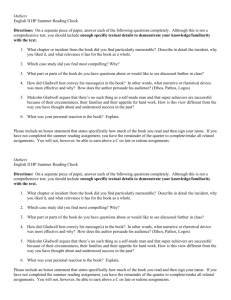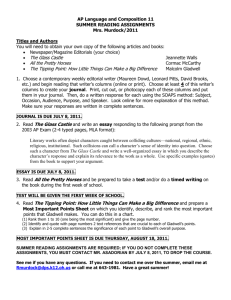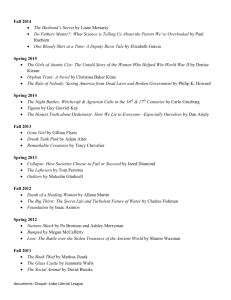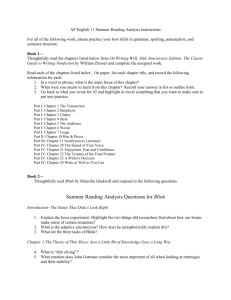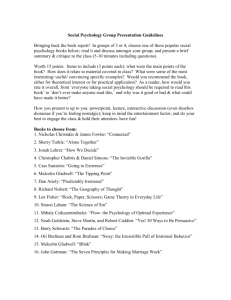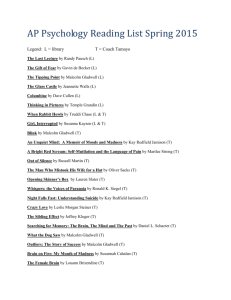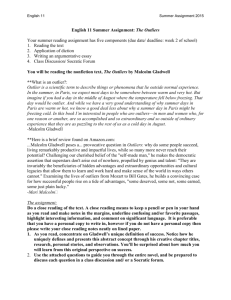If You Blink, You May Be An Outlier, and Miss The Tipping Point: A
advertisement
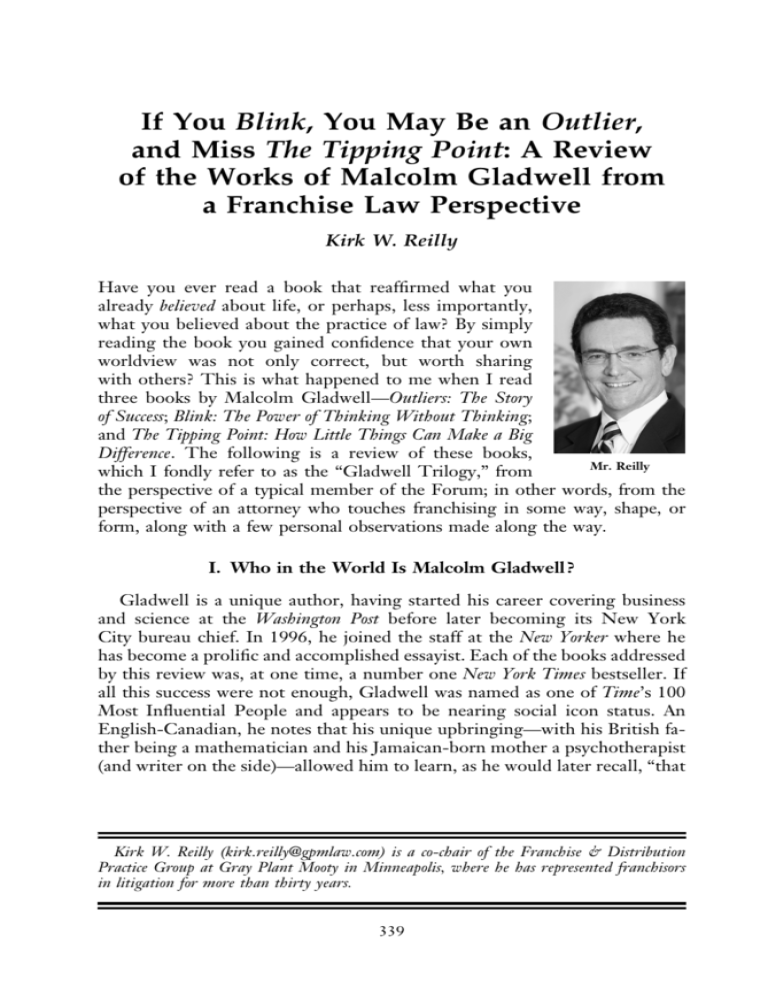
If You Blink, You May Be an Outlier, and Miss The Tipping Point: A Review of the Works of Malcolm Gladwell from a Franchise Law Perspective Kirk W. Reilly Have you ever read a book that reaffirmed what you already believed about life, or perhaps, less importantly, what you believed about the practice of law? By simply reading the book you gained confidence that your own worldview was not only correct, but worth sharing with others? This is what happened to me when I read three books by Malcolm Gladwell—Outliers: The Story of Success; Blink: The Power of Thinking Without Thinking; and The Tipping Point: How Little Things Can Make a Big Difference. The following is a review of these books, Mr. Reilly which I fondly refer to as the “Gladwell Trilogy,” from the perspective of a typical member of the Forum; in other words, from the perspective of an attorney who touches franchising in some way, shape, or form, along with a few personal observations made along the way. I. Who in the World Is Malcolm Gladwell ? Gladwell is a unique author, having started his career covering business and science at the Washington Post before later becoming its New York City bureau chief. In 1996, he joined the staff at the New Yorker where he has become a prolific and accomplished essayist. Each of the books addressed by this review was, at one time, a number one New York Times bestseller. If all this success were not enough, Gladwell was named as one of Time’s 100 Most Influential People and appears to be nearing social icon status. An English-Canadian, he notes that his unique upbringing—with his British father being a mathematician and his Jamaican-born mother a psychotherapist (and writer on the side)—allowed him to learn, as he would later recall, “that Kirk W. Reilly (kirk.reilly@gpmlaw.com) is a co-chair of the Franchise & Distribution Practice Group at Gray Plant Mooty in Minneapolis, where he has represented franchisors in litigation for more than thirty years. 339 340 Franchise Law Journal • Vol. 33, No. 3 • Winter 2014 there is beauty in saying something clearly and simply.”1 As attorneys, the ability to “say something clearly and simply” is a worthy goal, although one that often proves to be surprisingly hard to attain. In my view, Gladwell can take relatively complex issues of social phenomenon and distill them down to pithy and entertaining prose—many times utilizing nothing more than multiple “stories” leading to a conclusion. One reviewer summarizes Gladwell’s style by stating that he “excels at pinpointing a social phenomenon, be it cultural epidemics (The Tipping Point) or snap judgments (Blink); putting forth his thesis; and illustrating his proof through a series of short, engaging, self-encapsulated histories.”2 Another gushes that Malcolm Gladwell is also a mega-selling author. Combining graceful writing, his own reporting and academic research, as well as anecdotal evidence, Gladwell’s books connect the dots in startling, often counterintuitive ways to create novel theories of familiar phenomena in The Tipping Point, Blink and Outliers.3 When asked for the process behind his writing, Gladwell said, “I have two parallel things I’m interested in. One is, I’m interested in collecting interesting stories, and the other is I’m interested in collecting interesting research. What I’m looking for is cases where they overlap.”4 This style of writing struck me as a franchise lawyer’s dream—a style that takes complex issues down to the lay level and communicates them in the form of short, yet entertaining, stories. II. Drinking the Gladwell Kool-Aid The book-buying public and most critics agree that Gladwell is a skilled writer and storyteller. But what does Gladwell try to tell us in the trilogy, and, as importantly, why should we care? Let’s start with a basic question—how does a reader “feel” while reading the trilogy? In my case, I found that each book supplied me with justification for several of my most basic and strongly held beliefs about life, human behavior, and, to a lesser extent, the practice of law as a franchisor-side litigator.5 Yet, while I admit to being a Gladwell evangelist, I do so with a healthy appreciation that sometimes there are reasons that complex social/scientific phenomenon cannot easily be explained in Gladwell’s style—at least not 1. David Leonhardt, Chance and Circumstance, Book Review of Outliers, N.Y. TIMES, Nov. 30, 2008, at 2. 2. Mark Flanagan, Outliers by Malcolm Gladwell, About.com Contemporary Literature, http:// contemporarylit.about.com/od/socialsciences/fr/outliers.htm. 3. Brian Bethune, Malcolm Gladwell on the Secret Power of the Underdog, MACLEAN’S, Sept. 24, 2013, http://www2.macleans.ca/2013/09/24/the-perils-of-being-the-worst-of-the-best-and-howthe-weak-turn-adversity-to-advantage/. 4. Eric Jaffe, Malcolm in the Middle, APS OBSERVER, Mar. 2006. 5. Before reading the trilogy, I believed that (1) IQ is overrated as compared to EQ; (2) I ought to trust my gut instincts more often in key situations; (3) any “success” I may have attained is attributable to many things I cannot explain nor, in many cases, control; and (4) experience really does come in handy when tough decisions need to be made. A Review of the Works of Malcolm Gladwell 341 without rigorous examination of alternative, and in some cases, contradictory, evidence and theory.6 For, as with many of us, in Gladwell’s case sometimes one’s greatest strength (simplified, engaging, and popular prose) can also be one’s greatest weakness (lack of boring, but sometimes needed, quantifiable scientific evidence). The purpose of this review is to expose Franchise Law Journal readers to Gladwell’s books and particular theories espoused in each one of them as well as encourage readers to make up their own minds as to the applicability and merit of these theories in their own lives and practices. III. Introduction to the Gladwell Trilogy A. Outliers In Outliers, Gladwell makes an argument that it is not the brightest who succeed, nor is success simply the sum of the decisions and efforts we make on our own behalf. It is, rather, a gift. Outliers are those who have been given opportunities—and who have had the strength and presence of mind to seize them.7 This basic premise can greatly affect subjects as varied as law firm hiring practices, franchisee selection criteria, and franchisor executive recruiting. Gladwell notes that he wrote Outliers because he grew frustrated with the way society explains the careers of really smart people. You know how you hear someone say of Bill Gates or some rock star or some other outlier—“they’re really smart,” or “they’re really ambitious?” Well, I know lots of people who are really smart and really ambitious, and they aren’t worth 60 billion dollars. It struck me that our understanding of success was really crude—and there was an opportunity to dig down and come up with a better set of explanations.8 Interestingly, one reviewer noted that although Outliers doesn’t actually tell Gladwell’s life story, “he lurks offstage, since he does describe the arc of his mother’s Jamaican family.”9 This book is clearly personal to Gladwell, and the content of the examples he provides will, at a minimum, cause readers to think about what it means to be “successful” and perhaps reconsider how much our own brains, drive, and ambition had to do with whatever “success” we may have achieved. 6. In discussing Gladwell’s work, one reviewer stated that “[Gladwell’s work] is a pleasure to read and leaves you mulling over its inventive theories for days afterward. It also, unfortunately, avoids grappling in a few instances with research that casts doubt on those theories. . . . This is a particular shame, because it would be a delight to watch someone of [Gladwell’s] intellect and clarity make sense of conflicting claims.” David Leonhardt, Chance and Circumstance, Book Review of Outliers, N.Y. TIMES, Nov. 30, 2008, at 2. 7. Id. 8. MALCOLM GLADWELL, OUTLIERS: THE STORY OF SUCCESS (2008), Q and A with Malcolm, Outliers, http://gladwell.com/outliers-q-and-a-with-malcolm/. 9. Leonhardt, supra note 6, at 2. 342 Franchise Law Journal • Vol. 33, No. 3 • Winter 2014 B. Blink In Blink, Gladwell focuses on the theory of “thin-slicing:” the ability to make judgments by “filtering very few factors that matter from an overwhelming number of variables.”10 He opines that spontaneous decisions are often as good as, or even better than, carefully planned and considered ones. Gladwell believes that we live in a society dedicated to the idea that we’re always better off gathering as much information, and spending as much time, as possible in deliberation, yet, there are lots of situations—particularly at times of high pressure and stress— when haste does not make waste, when our snap judgments and first impressions offer a much better means of making sense of the world.11 Gladwell describes the power of our brains to subconsciously sift through huge amounts of information, blend data, isolate key details, and come to astonishingly rapid conclusions—even in the first two seconds of seeing something.12 He summarizes Blink as a book about trying to understand those first two seconds. . . . What is going on inside our heads when we engage in rapid cognition? When are snap judgments good and when are they not? What kinds of things can we do to make our powers of rapid cognition better?13 C. The Tipping Point In The Tipping Point, Gladwell studies social epidemics (“fads” or “trends,” if you like) and offers the theory that there are certain patterns and factors typically present in virtually every influential trend, ranging from the surprising popularity of Hush Puppies shoes in the mid-1990s to the equally surprising rapid decline in the New York City crime rate after 1990. In essence, Gladwell posits that “ideas and products and messages and behaviors spread like viruses do.”14 As importantly, Gladwell believes that “big changes follow from small events, and that sometimes changes can happen very quickly.”15 Gladwell hopes that readers of this book, including businesses trying to spread the word about their products, come away thinking about starting “positive” epidemics of their own.16 This theory has potential for application in the world of franchise law, particularly in the areas of franchise standards enforcement, franchisor-franchisee relations, and, of course, product development and marketing at the store and system levels. 10. Id. 11. Malcolm Gladwell, Q and A with Malcolm, Blink, gladwell.com, http://gladwell.com/ blink-blink-q-and-a/. 12. David Brooke, Blink: Hunch Power, Book Review of Blink, N.Y. TIMES, Jan. 16, 2005, at 2. 13. MALCOLM GLADWELL, BLINK: THE POWER OF THINKING WITHOUT THINKING (2005), Reading Group Guide, A Conversation with Malcolm Gladwell, at 2–3. 14. MALCOLM GLADWELL, THE TIPPING POINT: HOW LITTLE THINGS CAN MAKE A BIG DIFFERENCE 7 (2000). 15. Id. at 11. 16. Malcolm Gladwell, Q and A with Malcolm, The Tipping Point, gladwell.com, http:// gladwell.com/the-tipping-point/the-tipping-point-q-and-a/. A Review of the Works of Malcolm Gladwell 343 IV. Gladwell’s Gift—Effective Use of Anecdotes In order to review the Gladwell trilogy and give a fair overview of his theories, it is absolutely necessary to discuss a few “anecdotes” from each book. The following anecdotes, organized by book, provide a glimpse into the power of Gladwell’s writing technique—interesting stories with a lesson applicable to our world, and, in most cases, applicable to the practice of franchise law and franchising itself. A. Outliers 1. Youth Hockey in Canada and the Secret of Birthdays Of the three books in the trilogy, Outliers probably resonates most deeply with me on a personal level. Each anecdote Gladwell provided caused me to reflect on my own life and career—how much of where I ended up was due to my own abilities and how much was due to other factors?17 Gladwell starts Outliers with an observation about the disproportionate number of elite Canadian hockey players born in the first few months of a calendar year. A review of all-star team rosters showed the vast majority of players were born in January, February, or March.18 Why? Because in Canada, the cut-off date for youth hockey registration is January 1. Players born on January 1 play in the same league as players born on December 31 of the same year. At early ages, this twelve-month difference in age (and corresponding difference in size, strength, maturity, etc.) creates a tremendous advantage for those players born in the beginning of any year. The young players who are bigger and stronger are identified as better athletes, leading to selection to more elite teams, with better coaching, facilities, and more ice time. Over time, the advantage these “January” players enjoy grows at an accelerated pace. Gladwell labels this phenomenon, in which “the rich get richer and the poor get poorer,” as “accumulative advantage.”19 He makes a strong point that success depends on the idiosyncrasies of the selection process used to identify talent just as much as it does on any individual’s natural abilities. An example in the legal profession comes to mind—on-campus recruiting of summer associates. Since the long-held process for recruiting summer associates calls for law firms to interview law students at the beginning of their 17. For instance, if you want to be a franchise lawyer, Minneapolis is not a bad place to practice. For reasons that, to this day, are not clearly understood, a disproportionate number of lawyers who make a living in the franchise space practice in Minneapolis. I started my legal career at a boutique firm in Minneapolis that happened to have a number of franchisors as clients. Initially, I worked on every type of lawsuit that came in the door, for every type of client, but eventually started handling more and more cases on behalf of the firm’s franchisor clients. Several law firm mergers and one lateral move later, I find myself as co-chair of a nationally respected franchise practice group with thirty lawyers. Was my career path intentional? Of course not. Was it influenced by opportunities not of my making? Clearly. Was my location a key factor? Absolutely. 18. OUTLIERS, supra note 8, at 22–24. 19. Id. at 30. 344 Franchise Law Journal • Vol. 33, No. 3 • Winter 2014 second year, the key factor in the selection process is, by default, academic performance during the first year of law school, period. Thus, candidates who have outstanding first-year academic performance are by and large, the pool of talent from which summer associates will be selected. But suppose law students have a few issues in their first year, affecting their grades, but grow and mature as the law school experience continues and have fantastic grades for the remainder of their careers. Inversely, successful candidates may not perform as well later in their law school careers. No matter, the selection process, limited to first year performance only, is blind as to the totality of the student’s law school career. Sound familiar? 2. Being Smart Enough One of the most provocative and yet fundamental claims that Gladwell makes in Outliers involves the relative credibility of standard test results (ACT, LSAT, IQ) as predictors of future performance, i.e., the ability to become an outlier. For instance, Gladwell opines that once a candidate for any competitive objective, i.e., a job, admission to law school, political office, has the minimum intellectual capability to succeed in a profession (say, the IQ necessary to get into a reasonably competitive graduate school), having additional IQ points does not translate into any measurable real world advantage. In essence, intellect and achievement are far from perfectly correlated. In other words, to succeed, candidates simply need to be “smart enough.”20 Once a candidate is “smart enough,” that candidate’s “practical” intelligence (or EQ), “knowing what to say to whom, knowing when to say it, and knowing how to say it for maximum effect,”21 is often the key to success. Practical intelligence appears more and more important in today’s business world, including in franchising. Interestingly, IQ and EQ are “orthogonal:” the presence of one doesn’t imply the presence of the other.22 This seems to correlate with those who succeed in law firms nowadays—people who can generate and maintain client business. In my experience, attorneys who excel in this area almost always have high levels of practical intelligence and EQ. 20. Id. at 85–86. 21. Id. at 101–02. 22. Gladwell also tells the somewhat heartbreaking tale of Chris Lanagan, an individual from a very poor and harsh family background, who, by all accounts, may have the highest IQ ever measured—approaching 200 (for context, Einstein’s IQ was about 150). Id. at 70. Gladwell compares Lanagan with Robert Oppenheimer, another high IQ individual, who came from a very privileged and nurturing background, and suggests that what got Oppenheimer the role as head of World War II’s Manhattan Project (the development of the atomic bomb), was not only his IQ, but his “practical intelligence,” or his EQ, which allowed him to be savvy enough to charm the head of the project, General Leslie Groves, into appointing him project director. Lanagan, coming from a stark and deprived background, developed none of these EQ skills and encountered difficulty dealing with the most basic life situations—like filling out the forms for financial aid or finding a publisher for his research. This lack of EQ skills caused his IQ to lie dormant and unrecognized, preventing him from exercising his unbelievable intellectual potential. Id. at 108–10. A Review of the Works of Malcolm Gladwell 345 Similarly, the franchise systems that tend to have less conflict and more unified energy to promote and grow the brand are those in which leadership demonstrate high levels of practical intelligence and EQ. To maintain a high-functioning team, it takes skills in dealing with people, not just raw intellect. Assuming most folks are “smart enough,” the key performers will be the ones who bring other gifts to the table, not just an extra twenty IQ points. An interesting example of this phenomenon in franchising may come to us from a popular CBS television show—Undercover Boss. The premise of Undercover Boss takes CEOs—in many cases, of franchisor companies,23 disguises them, and puts them to work on camera at entry level jobs at the store unit level. Viewers are left to observe how the CEOs handle the day-to-day stresses of unit level jobs, including the CEOs’ interaction with franchisees and their employees. Suffice it to say that the CEOs’ personalities, including their level of practical intelligence and EQ, certainly come out during the hour-long program. Certainly some CEOs handle the situations they face on camera better than others, and the ones with the higher EQs, but not necessarily the higher IQs, seem to represent their brands and their units with distinction. Does this correlate to better financial performance by their franchisor companies? That is unknown, but Gladwell’s theories would seem to predict the answer would be “yes.” 3. The 10,000 Hour Rule One of Gladwell’s more interesting theories, and one picked up by the popular press, is the 10,000 Hour Rule. Gladwell asserts that in any particular field (presumably including the practice of franchise law), outliers probably reach their lofty status through a combination of ability, opportunity, and utterly arbitrary advantage.24 One of the factors at work here is simple: hard work. Gladwell believes that the people at the very top do not just work harder; they work much, much harder. The emerging picture is that 10,000 hours of practice is required to achieve the level of mastery associated with being a world-class expert, in anything, including the thing we call “franchise law.”25 23. CEOs from many franchisors have appeared on the show, including Menchies, Buffets, Inc., Choice Hotels, Donatos, Twin Peaks, Fatburger, Moe’s Southwest Grill, KOA, PostNet, Cinnabon, Tilted Kilt, Fastsigns International, Popeyes Louisiana Chicken, Checkers & Rally’s, The Dwyer Group, and BrightStar Care. 24. OUTLIERS, supra note 8, at 37. 25. Id. at 40. For instance, many law firms have minimum billable hours standards of, say, 1,800 hours per year. However, query how many “billable” hours are really spent honing the craft of being a true franchise attorney? Let’s use 1,000 hours as the appropriate yearly number. Thus, under Gladwell’s theory, it would take approximately ten years of practicing franchise law to become what Gladwell categorizes as an expert in the field. That sounds about right—but I would argue that 1,000 hours per year of franchise-related experience is a bit ambitious for most of our younger lawyers—thus requiring a few more years to obtain “expert” status. That said, those lawyers who work for firms that have practices that concentrate on franchise law are seemingly at an advantage (sound familiar) over lawyers at firms that have less concentrated work in the area. 346 Franchise Law Journal • Vol. 33, No. 3 • Winter 2014 4. Bill Gates and the Beatles The subjects of Gladwell’s anecdotes are familiar, yet surprising. Gladwell starts with Bill Gates. While describing Gates’s childhood and his not insignificant socioeconomic and academic advantages,26 Gladwell comes to the conclusion that in 1975, a key year in the development of personal computing, the number of people on the planet who had the same or similar opportunity to develop comparable computer programming skills would be less than fifty.27 By the time Gates dropped out of Harvard as a sophomore to form what eventually became Microsoft, he had surpassed far more than 10,000 hours of programming. In fact, Gates admits that he had better exposure to software development at a young age than anyone did in that period of time, all because of an incredibly lucky series of events.28 Another great anecdote involves a rock band you may have heard of, The Beatles. The Beatles’ great advantage was that they played live at gigs at the rock ‘n’ roll clubs and strip clubs of Hamburg, Germany, during the early ’60s. In Hamburg, The Beatles’ gigs would often require that they be on stage, playing for eight straight hours, often seven days a week. During their time in Hamburg, they performed over 270 nights of live music. By the time they burst on the scene in 1964, they had performed live an estimated 1,200 times.29 This is extraordinary when compared to the other rock groups of the day. The Beatles not only developed tremendous stamina, but they also learned to play an enormous number of songs—cover versions 26. It gets better. Gates’ school, the Lakeside School, started a computer club when Gates was in seventh grade. The Mothers’ Club held a rummage sale and used $3,000 to purchase a time-sharing computer terminal with a direct link to a mainframe in downtown Seattle. From that point on, Gates lived in the school’s computer room. A local group of programmers at the University of Washington (UW) formed a company and asked if the Lakeside Computer Club would be willing to test out the company’s software on weekends in exchange for free programming time. Gates took the bus after school to this outfit’s offices and programmed long into the evening. When that outfit went bankrupt, Gates and his buddies began hanging out at the University of Washington’s computer center (a bike ride away). It did not take long before they latched onto an outfit, ISI, which agreed to let them have free computer time in exchange for working on a piece of the company’s software. At this point, at age 16, Gates and his buddies ran up 1,575 hours of computer time on the company’s mainframe, which averages out to 8 hours a day, 7 days a week. He and classmate Paul Allen found a computer at the University of Washington that was free to use between 3 a.m. and 6 a.m. Gates would leave home at night after bedtime and use the UW computer. One of the founders of ISI had a pressing need for programmers for a big project—his first thought was those high school kids from Lakeside who were running up thousands of hours on the UW mainframe. Gates was able to convince his teacher to let him go take this programming gig as an independent study project. By the time Gates dropped out of Harvard in his sophomore year to try his hand at forming his own software company, he’d been programming practically nonstop for the better part of seven years. Id. at 51–55. 27. Id. at 55. To be part of the coming revolution in personal computing and not stuck in the old world order of mainframe computing, it would be optimum to be twenty or twenty-one years old in 1975, the year Popular Electronics ran a cover story on the Altair 8800—the first do-it-yourself (build at home) personal computer. Gates, Paul Allen, Steve Ballmer, Steve Jobs, and Eric Schmidt were all born within a year or two of 1955. Id. at 65–68. 28. Id. at 55. 29. Id. at 49–50. A Review of the Works of Malcolm Gladwell 347 of many genres, not just rock ‘n’ roll, but jazz, blues, and country. Before Hamburg, they were undisciplined. After Hamburg, they sounded like no one else in the world.30 We can debate whether the 10,000 Hour Rule should have a different quantitative title (e.g., 15,000 Hour Rule, 20,000 Hour Rule), but it makes perfect sense that a significant level of experience in franchising is required for one to be an expert, and that expert status is needed before “thin-slicing” can have significant reliability for our clients. 5. The New York Law Firms and Demographic Luck The final anecdote I will share from Outliers involves, appropriately enough, the legal profession. Gladwell introduces us to Joe Flom, the last living named partner of Skadden Arps Slate Meagher and Flom and a legendary corporate litigator who, like many in his generation at the top ranks of the profession in New York, happened to be Jewish. Gladwell concedes that no one rises to the top of the New York legal profession unless he or she is smart or ambitious and hardworking, and clearly Joe Flom and other members of his generation who achieved similar success fit that description.31 But to have so many similar individuals with similar backgrounds reach the top of the same profession at about the same time shows us that something else may have been at work.32 Gladwell notes that Joe Flom certainly had intelligence, personality, and ambition, but that the true story of Joe Flom’s life turns out to be much more intriguing than the mythological version because all the things in his life that seemed to have been disadvantages—that he was a poor child of garment workers; that he was Jewish at a time when Jews were heavily discriminated against; that he grew up in the Depression—turn out unexpectedly to have been advantages.33 Gladwell postulates that key environmental and demographic factors created a perfect storm that favored a specific type of individual to rise to the top of the legal profession during the latter part of the twentieth century. He theorizes that the candidate to be the perfect corporate lawyer in 1970, when corporate takeovers began to revolutionize the practice of “corporate law,”34 would have been born in a demographic trough in the 1930s so as 30. Id. 31. Id. at 155. 32. Id. at 156–58. 33. Id. at 120. 34. For, at this time and place, the old-line Wall Street firms had very specific ideas about what it was they did. Id. at 124. They were corporate lawyers. They did not do litigation: that is, very few of them had litigation departments dedicated to defending and filing lawsuits. But, even if they did some litigation, they certainly did not become involved in hostile corporate takeovers. Thus, the work that came in the door to the generation of Jewish lawyers from the Bronx and Brooklyn in the 1950s and 1960s was the work these established law firms disdained: litigation and, more specifically, proxy fights, which were the legal maneuvers at the center of any hostile take-over bid. Id. at 125. Joe Flom became an expert in taking in the business of proxy fights. By the 1970s, companies needed to be defended against lawsuits by rivals, and 348 Franchise Law Journal • Vol. 33, No. 3 • Winter 2014 to have the best of New York’s public schools and the easiest time in the job market. He would be Jewish and thus blocked out of the old-line downtown law firms on account of his “antecedents.”35 His parents would have done meaningful work in the garment business, passing on to their children autonomy and complexity and the connection between effort and reward.36 A good school—although it does not have to be a great school—would have been attended. He need not have been smartest in the class, only smart enough. If there is a perfect birthdate for the New York Jewish lawyer, Gladwell speculates that it would be 1930, because that would give the lawyer the benefit of being a member of a relatively small generation class. It would also make him 40 years old in 1970,37 thus at his prime just as the biggest phenomenon in corporate law—the hostile takeover boom—began to dominate the hearts and minds of corporate America. 6. The Richest Generation (of All Time) Gladwell tells another story of the power of when one is born, at least by generation, when discussing the wealthiest persons in recorded history. Of the seventy-five names on that list, fourteen are American, all born within nine years of one another during the mid-1800s.38 Almost 20 percent of the names on the list (from the days of Cleopatra to the present) come from a single generation in a single country. Why? These men were born during the specific time when the American economy was going through the greatest transformation in its history. It was the time of the building of the railroads, the beginning of industrial manufacturing, and the emergence of Wall Street.39 It was when all the old rules of the economy were being broken and remade— hostile suitors needed to be beaten back. Investors who wanted to devour unwilling targets needed help with their legal strategy, and shareholders needed formal representation. From the mid-1970s to the end of the 1980s, the annual amount of money involved in mergers and acquisitions on Wall Street increased 2,000 percent. The established white-shoe law firms, which previously thought hostile takeovers were beneath contempt, were late to the game, and Joe Flom found that once he had gotten the reputation for doing that kind of work, the business came to him. As a contemporary at the time stated, it is not that those guys were smarter lawyers than anyone else; they simply had a skill that they had been working on for years that was suddenly very valuable. Id. at 129. 35. In the 1940s and 1950s when Flom and others of his generation were coming to the legal ranks, the old-line law firms of New York operated like a private club. Id. at 122. If you were not of the right background in religion and social class and you came out of law school in that era, you joined some small, second-rate upstart law firm on a rung below the big names downtown, or you simply went into business for yourself and took “whatever came in the door.” Id. at 124. 36. Most people agree that three things—autonomy, complexity, and a connection between effort and reward—are the three qualities that work has to have if it is to be satisfying. Id. at 149. It is not how much money we make that ultimately makes us happy between nine and five. It’s whether our work fulfills us. Id. at 151. The most important consequence of the miracle of the garment industry, however, was what happened to the children growing up in those homes where meaningful work was practiced. They learned that if you work hard enough and assert yourself and use your mind and imagination, you can shape the world to your desires. Id. 37. Id. at 156. 38. Id. at 61. 39. Id. at 62. A Review of the Works of Malcolm Gladwell 349 and opportunity was ripe for transformative wealth for those who were at the right place at the right time—but they had to be present for a nine-year window that was perfect for seizing what the future held.40 One could make a similar observation about the realm of franchise law and both demographic luck and generational timing. The late 1960s was probably franchising’s transformative growth period. If we trace back the history of the practice of franchise law to its origins, we may well find ourselves looking at the history of the International Franchise Association (IFA), which was born around 1960 in Chicago.41 The early founders of the IFA, including Bill Rosenberg of Dunkin’ Donuts, determined that the IFA’s role was to “enhance and safeguard the business environment for franchisees and franchisors worldwide.”42 Rosenberg noted the importance of IFA in the legal and legislative arena.43 The great need to concentrate IFA’s efforts on legal and legislative matters spurred IFA to relocate from Chicago to Washington, D.C.44 At about the same time, IFA invited Phil Zeidman, then of the D.C. firm Brownstein, Zeidman and Schomer, to represent the IFA as Washington counsel.45 From that point on, in light of the regulatory nature of franchising, Washington, D.C. became the focus of the franchise legal community—with offshoots in Chicago, where Lew Rudnick, of Rudnick and Wolf, another early titan of franchise law, had his practice. Historically, if you wanted to be on the ground floor of the practice of franchise law, Washington or Chicago would be where the action was, and the lawyers associated with Zeidman, Rudnick, and their respective firms (who would, later in time, merge together and eventually become a firm that today is known as DLA Piper) were the original legal “early adopters.” Over time, other hotbeds of franchise law developed, including, strangely enough, Minneapolis. The above-mentioned vanguards of the franchise bar certainly had intelligence, personality, and ambition. They also had, in Gladwell’s view, “demographic luck.” As a final thought, one reviewer believes that Outliers is, at its core, Gladwell’s manifesto: We look at the young Bill Gates and marvel that our world allowed a 13-year old to become a fabulously successful entrepreneur, Gladwell writes, but that’s the wrong lesson. Our world only allowed one 13-year old unlimited access to a time-sharing terminal in 1968. If a million teenagers had been given the same opportunity, how many more Microsofts would we have today?46 40. Id. at 63. 41. International Franchise Association Timeline of Events, http://emarket.franchise.org/ Timeline/IFA-Timeline25.html. 42. Id., Prologue. 43. Id., The Mission. Rosenberg stated that “When people got hurt and lost their money in a franchise arrangement, the first thing they did was to complain to their congressman or state legislator. These guys, not knowing anything about franchising or having any credible source of information, wanted to pass laws that would make it difficult to survive as a franchisor. The goal of IFA was to educate the public and the lawmakers.” 44. Id., A Washington Presence. 45. Id. 46. Id. at 268. 350 Franchise Law Journal • Vol. 33, No. 3 • Winter 2014 In essence, Gladwell is urging us to rethink what allows individuals to succeed, and think about what institutions we can build up, in order to foster the success of many. B. Blink In Blink, Gladwell examines the concept of rapid cognition, the kind of thinking that happens in a blink of an eye,47 and advocates that spontaneous decisions are often as good as—or even better than—carefully planned and considered ones. There is a caveat, however, as one must make sure to focus on the correct few factors and not be corrupted by personal likes and dislikes, prejudices, and stereotypes.48 This is, of course, easier said than done. The following are examples of some of the anecdotes Gladwell uses in Blink to illustrate his theories. 1. Oops—The Getty Museum’s $10,000,000 Error Gladwell opens Blink with the story of the Getty Museum in Los Angeles and its prize purchase—a “Kouros,” an ancient Greek statue of a youth. Only 200 of these types of statues are in existence and most have been badly damaged or are in fragments—this piece was intact and almost perfectly preserved. The asking price was $10,000,000, and Getty was about to make the purchase, subject to an evaluation to make sure the statue was authentic.49 All available modern technology was employed in examining the piece, as was an inspection of the supporting documentation by Getty’s legal team. Fourteen months after starting its “evaluation,” Getty decided to purchase the statue. When it went on display, however, it became clear to certain experts that Getty had a problem—the statue did not look right. One art historian, seeing the statue for the first time, found himself staring at its fingernails. In a way he could not articulate—they seemed “wrong.” Another art expert, in town just before the purchase, saw the statue and had a hunch—an instinctive sense that something was amiss. Another expert saw the statue and recalls that the first word that went through his head was “fresh.” Gladwell notes that the word “fresh” is not the anticipated reaction one should have to an allegedly two thousand-year-old statue.50 These experts had come to one conclusion (the statue was a fake) after just gazing upon the statue for the first time, whereas Getty’s experts and lawyers, after painstaking analysis, had come to a different conclusion (the statue was authentic). The statue ended up being a fake, made in a forger’s workshop in Rome in the early 1980s. When the art experts viewed the statue and felt an “intuitive repulsion,” they were right. Gladwell notes that “in the first two seconds of looking—in a single glance—they were able to understand 47. Malcolm Gladwell, Q and A with Malcolm, Blink, gladwell.com, http://gladwell.com/ blink-q-and-a-with-malcolm/. 48. BLINK, READING GROUP GUIDE, A CONVERSATION WITH MALCOLM GLADWELL, at 5–6. 49. MALCOLM GLADWELL, BLINK 3–5 (2005). 50. Id. at 5–8. A Review of the Works of Malcolm Gladwell 351 more about the essence of this statue than the team at Getty was able to understand after fourteen months.”51 Blink goes on to discuss the “adaptive unconscious,” which is a part of the brain that Gladwell believes “does an excellent job of sizing up the world, warning people of dangers, setting goals and initiating action in a sophisticated and efficient manner.”52 Before our franchisor clients begin requiring us to make snap judgments based upon our gut reaction to legal problems— without the necessity of factual and legal analysis—it must be pointed out that not everyone buys Gladwell’s conclusions. For instance, no stranger to strong opinions, Judge Richard Posner of the Seventh Circuit reviewed Blink and argued that Gladwell fails to support his own recommendations regarding thin-slicing and makes a variety of unsupported assumptions and mistakes in his characterizations of the evidence for his thesis.53 In his 2005 review of Blink, David Brooks of the New York Times wrote that Gladwell may be guilty of overstating his case as to the effectiveness of the adaptive unconscious and the doctrine of thin-slicing, noting the equally compelling arguments made by Michael Lewis in his bestseller, Moneyball. In Moneyball, Lewis shows us a baseball executive who uses rigorous statistical analysis to “clobber fuzzy-minded old pros who relied on their gut impressions” of the relative worth of major league ballplayers.54 You can decide the merits of Gladwell’s theories based on your own experiences. 2. The Beauty of Screening—“That’s Who We Want!” Gladwell posits that inherent in the “thin-slicing” phenomenon is the need to be aware of how our own prejudices and biases can clearly disrupt our adaptive subconscious. He tells the compelling story of professional musician Abby Conant, who, in the summer of 1980, applied for eleven openings in orchestras across Europe. She received one response—from the Munich Philharmonic Orchestra. Since one of the applicants was the son of an orchestra member, the auditions were to be held behind a screen to promote “fairness.” Conant was the sixteenth applicant to play, but play she did. She was fantastic! Auditions are classic “thin-slicing” moments, and trained classical musicians can tell if someone is talented in a matter of moments.55 The maestro, hearing Conant’s performance, screamed, “That’s who we want!” Conant emerged from behind the screen to stunned silence—she was a woman and a trombone player—a classically male position. Although she did join the orchestra she was over time repeatedly demoted, because, she was told, “We need a man at first trombone.”56 Eventually she brought a dis51. Id. at 8. 52. Id. at 12. 53. Richard A. Posner, Blinkered, NEW REPUBLIC, Jan. 17, 2005, available at http://www.tnr. com/article/blinkered. 54. David Brooks, ‘Blink’: Hunch Power, N.Y. TIMES, Jan. 16, 2005, at 3. 55. BLINK, supra note 49, at 245–56. 56. Id. at 247. 352 Franchise Law Journal • Vol. 33, No. 3 • Winter 2014 crimination suit against the orchestra seeking to be reinstated as first trombone. After years of litigation, and ultimate reinstatement, she also had to bring suit to receive pay equal to what her male peers were paid. Not surprisingly, Conant prevailed at every turn. Why? Under conditions of perfect objectivity, and in an unbiased moment, the orchestra leader had thin-sliced Conant’s performance and yelled, “That’s who we want,” sending the remaining trombonists packing.57 This is a great lesson for all of us who do engage in thin-slicing, but perhaps do not employ all that many screens while doing so. I would challenge those selecting candidates for any position—whether a general counsel of a franchisor seeking to hire outside counsel, a partner at a law firm looking to hire an associate, a franchisor seeking to hire a director of franchise development, or a franchisee hotel operator seeking to hire a night manager—to seriously think about the above anecdote and their own preconceptions of what they are looking for in the selection they are about to make. For, as the next anecdote drives home (particularly to me, since I am five feet ten inches tall on a “good day”), we all have unconscious bias that for most of us ultimately affects our actions. 3. Tall Equals Good and the Warren Harding Error As a further cautionary tale, Gladwell points out that U.S. companies disproportionately hire tall men to be their CEOs. In the U.S. population, 14.5 percent of men are six feet or taller. Among U.S. CEOs, 58 percent are six feet or taller. More troubling still, 3.8 percent of U.S. men are six feet two or taller, while more than a third of U.S. CEOs are six feet two or taller. According to Gladwell, there is an unconscious bias in favor of tall men—we have a powerful stereotype that leaders are tall.58 To add insult to injury, Gladwell has a chapter about the “Warren Harding Error,” which discusses the fact that the twenty-ninth president of the United States looked like what a president “should” look like: tall, dark, handsome, and distinguished. A powerful politico of the time saw Harding and, in a manner of seconds, thought this man would make a great president.59 Unfortunately, Harding would go down in history as one of the worst of all presidents,60 lacking in intelligence, vague and ambivalent on matters of policy, a boring public speaker, and, perhaps a precursor to the future, having sexual appetites that were the stuff of legend.61 Gladwell cites to Harding’s presidency as being the product of the dark side of rapid cognition62 and admonishes us to “acknowledge and understand those circumstances 57. 58. 59. 60. 61. 62. Id. Id. Id. Id. Id. Id. at at at at at at 246. 86–88. 72–73. 75. 72–75. 76. A Review of the Works of Malcolm Gladwell 353 when rapid cognition leads us astray.”63 We must all understand that thinslicing, while effective, must be managed to take into account our prejudices, both conscious and unconscious. 4. Is There Something to This? Clients pay lawyers a great deal of money for their expertise, yet one very powerful tool that can, according to Gladwell, provide them with the greatest return may well be the feeling in their lawyer’s gut. This theory can be interpreted at some level to challenge what most lawyers are trained to do—perform as much research, fact gathering, and analysis as humanly possible (within reason and the client’s budget) to increase the odds of a favorable outcome. In one sense, Gladwell would encourage our clients to have us provide them with our instant “gut feeling” on the issue facing them, so long as it is the result of adequate experience, training, and knowledge—without unaddressed bias or prejudice. Most lawyers, I suspect, have, at the moment of truth—whether examining a key witness on cross-examination, conducting voir dire, or determining whether to insert an arbitration clause in a franchise agreement—experienced that feeling of “butterflies” in the stomach, ringing in the ears, a headache, or some other physical “signal” that they need to act or change course. In hindsight, many of us have probably done a post-mortem of a trial or deal gone bad and made a statement along the lines of “that didn’t feel right,” “didn’t smell right,” or “I had a bad feeling right at the get-go.” Along those same lines, when discussing concluded franchisee-initiated litigation with franchisor executives—good outcome or bad—one of the most common comments I hear, in fact, that is almost universal in nature, is: “I had a bad feeling about that guy when we signed him up, something just didn’t feel right to me. I wish I had paid more attention at the time we signed him up.”64 Maybe we do need to pay attention to rapid cognition and particularly the concept of thin-slicing to learn how to increase the odds of it working properly. For the concept of “thin-slicing” to work, however, one does need a certain level of experience and knowledge in a field.65 For instance, those of us who remember our first jury trial will likely recognize now how “green” we were then and how little we truly knew about the process. If, at our first trial, we were to make a quick, Blink-like judgment, our experience levels were so lacking that I shudder to recall what “decisions” may have been made based upon our “infant stage” “gut” reactions. Experience is not 63. Id. 64. My esteemed colleagues of the franchisee bar have, I’d wager a bet, experienced similar situations—i.e., their clients reporting a similar bad feeling when they came away from a franchisor’s discovery day or presale meeting with the development team, yet failed to heed their gut and went ahead anyway and executed the twenty-year franchise agreement with a system that later proved, at least in their minds, not to be what it seemed. 65. See the 10,000 Hour Rule (chapter 2) in OUTLIERS, supra note 8. 354 Franchise Law Journal • Vol. 33, No. 3 • Winter 2014 cheap, but it does have serious value in our profession, and it is a prerequisite to enable the “thin-slicing” process to have any chance of reliability. C. The Tipping Point 1. What Makes an Epidemic Tip? In The Tipping Point, Gladwell notes that a “tipping point” is the magic moment when an idea, trend, or social behavior crosses a threshold, tips, and spreads like wild fire, i.e., like an epidemic.66 Gladwell believes that there are three rules of epidemics—the law of the few, the stickiness factor, and the power of context. 2. The Law of the Few The law of the few includes the classic 80/20 principle that in any situation roughly 80 percent of the work will be done by 20 percent of the participants. We are all familiar with this concept. But the people who do the majority of the work, the law of the few, are very special people. In this context, epidemics are, in essence, word of mouth phenomena. Gladwell believes that we need connectors, the kinds of people who know everyone and possess special gifts for bringing the world together.67 Connectors know a lot of people. They are sprinkled among every walk of life and have a truly extraordinary knack of making friends and acquaintances.68 Here’s where it gets interesting. Connectors are masters of what sociologists call the “weak tie,” a friendly yet casual connection. They know many people and have some level of relationship with those people, but they are not necessarily best friends or deeply involved. In essence, they are super acquaintances. Ironically, the data supports that people seeking employment generally do not obtain work through friends or family members; it is through acquaintances and their mastery of the “weak tie.”69 The reason—our friends and family occupy the same world we do, while our acquaintances, on the other hand, often occupy very different worlds and are thus exposed to people we would not necessarily come in contact with.70 Gladwell posits that acquaintances are a source of social power—the more acquaintances you have, the more powerful you are.71 I challenge you, at the next Forum you attend, to observe your fellow members at the opening reception. Watch for the connectors in the group, and, as importantly, listen to their conversations for how they go about making the “weak ties” that are at the heart of their social power. I would be willing to wager that you will be amazed at the number of “weak ties” that 66. The Tipping Point Reading Guide, http://gladwell.com/the-tipping-point/the-tippingpoint-reading-guide-intro/. 67. THE TIPPING POINT 38 (2002). 68. Id. at 41. 69. Id. at 54. 70. Id. 71. Id. A Review of the Works of Malcolm Gladwell 355 can be made in one evening and the relative ease with which connectors make these relationships. Connectors are often the “straw that stirs the drink” with respect to how information and, on occasion, behaviors, spread within an organization. The next type of people Gladwell believes are necessary for an epidemic to happen are the mavens. The word “maven” is Yiddish for one who accumulates knowledge.72 Mavens are motivated to educate and help—in reality, they are information brokers sharing and trading what they know.73 In a social epidemic, mavens are data banks. They provide the message. Connectors are social glue: they spread it. But it is the select group of people—salesmen—with the skills to persuade us when we are unconvinced of what we are hearing, who are as critical to the tipping point of word of mouth epidemics as the other two groups.74 For franchisors and their brands (and, of course, the involved franchisees), social epidemics leading to sales growth are the pot of gold at the end of the rainbow—yet, does anyone actually attempt to identify the roles of connectors, mavens, and salesmen in the process? Surmising that the answer may well be “no,” franchise brands may well have opportunities to explore how to increase the odds that positive social epidemics can be initiated, controlled, or even accelerated with a deeper understanding of the “law of the few.” 3. Sesame Street and Stickiness Epidemics need a “stickiness” factor to spread. Stickiness is counterintuitive—we all want to believe that the key to making an impact on someone lies with the inherent quality of the ideas we present—I suspect all lawyers believe this. However to “tip” a message and make it “stick” with the recipient, the presentation of ideas becomes the key factor.75 Gladwell shows us that at first, the pioneering television show for children, Sesame Street, failed to attract and keep children’s interest as they watched the show. Originally, based on the advice of child psychologists, all fantasy elements of the show were separated from real elements.76 Thus, the Muppets were only seen with other Muppets, not human characters. The testing showed this was a disaster, particularly when adults just talked to adults. Jim Henson and his coworkers went back and created puppets that could walk and talk with the adults on the show and could live alongside them on “Sesame Street.” Says Gladwell, “What we now think of the essence of Sesame Street—the artful blend of fluffy monsters and earnest adults—grew out of the desperate desire to be sticky.”77 72. 73. 74. 75. 76. 77. Id. Id. Id. Id. Id. Id. at at at at at at 60. 69. 70. 130–31. 105. 106. 356 Franchise Law Journal • Vol. 33, No. 3 • Winter 2014 Taking this concept to a franchise-related example, it would be interesting to see Subway’s initial test data on the potential effectiveness of its nowiconic spokesperson, Jared Fogle. Jared, as you probably recall, was a faithful Subway customer who lost 245 pounds by eating low-fat sandwiches at Subway and increasing his exercise. Did Subway know that Jared would be “sticky”? Probably not. Yet, since the advertising campaign featuring Fogle began, Subway sales have more than doubled to $8.2 billion, although the portion of the gain attributable to Fogle and his more than fifty Subway commercials cannot be determined.78 That said, a brief departure from Fogle in 2005 coincided with a 10 percent drop in sales, until Subway felt compelled to bring him back.79 Reportedly, Fogle has outlasted several advertising agencies for Subway, which almost certainly disliked the need to use Fogle, because of his popularity and effectiveness, instead of their own creative campaigns.80 As with many stories in franchising, the Jared phenomenon was made possible by a Subway Chicago-area franchisee, who saw an article about Jared’s weight loss using his self-described “Subway diet” and brought it to the attention of the franchisor’s Chicago advertising agency.81 The rest, as they say, is history. 4. Context—Crime and the City Gladwell discusses the power of context by exploring the rapid decline in the New York City crime rate in the 1990s. In essence, he believes that human behavior is sensitive to and strongly influenced by its environment, i.e., “epidemics are sensitive to the conditions and circumstances of the times and places in which they occur.”82 In the early 1990s, the powers that be in New York City decided to have “zero tolerance” with respect to minor “quality of life” crimes such as subway fare-beating, graffiti on public property, public drunkenness, loitering, and panhandling.83 “If you peed in the street—you were going to jail.”84 Radically, Gladwell suggests that the criminal—far from being someone who acts for fundamental, intrinsic reasons and who lives in his own world—is actually someone acutely sensitive to his environment, who is alert to all kinds of cues, and who is prompted to commit crimes based on his perception of the world around him.85 Thus, when the environment was less hospitable to criminal activity, this sent a message that affected the behavior of would-be criminals and reduced the crime rate for all kinds of criminal activity, both petty and major. 78. 79. 80. 81. 82. 83. 84. 85. Emily Bryson York, Subway Can’t Stop Jonesing for Jared, ADVERTISING AGE, Feb. 18, 2008. Id. Id. Id. THE TIPPING POINT, supra note 67, at 139. Id. at 145–46. Id. at 146. Id. at 150. A Review of the Works of Malcolm Gladwell 357 What, you may ask, do the lessons of crime in New York City have to do with the practice of franchise law or of franchising? Good question. Think for a moment about a franchisor that wishes to change franchisee behavior—perhaps to more closely resemble what the franchisor envisions as being required by the system operations manuals. This would be a big change, but how could it be attained without big costs or big pain? One example might be for the franchisor to start uniformly enforcing the small, often essential, system standards or contractual requirements that have generally been ignored in the past. Perhaps only half of the system actually provides the franchisor with the required profit and loss statements on a monthly basis or pays the royalty and marketing fund payments on the day they are due. Under Gladwell’s theory, these behaviors might change the overall environment of the entire system, allowing for more compliance on the “big” issues now that the “little issues” no longer exist. V. Conclusion As you may have observed by now, I have, indeed, drunk the Gladwell Kool-Aid. That said, I do retain a respectful dose of cynicism. I hope to use the lessons learned in the trilogy to not only be a better person, lawyer, and advocate, but also to perhaps try to improve something along the way. I encourage you to test the trilogy against your own view of the world and see if any of the concepts Gladwell offers make a difference.

